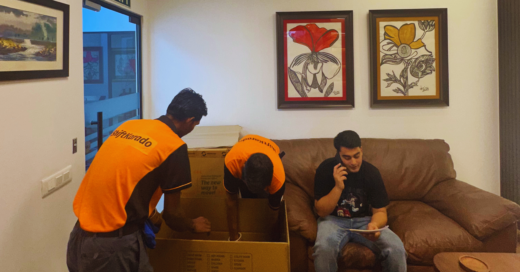Whether you’re a startup moving into your first office or a growing company needing more space, an office move is an exciting step. However, relocating your IT equipment requires careful planning to ensure everything runs smoothly without disrupting your business.
Feeling overwhelmed? It doesn’t have to be! Whether your IT team is small or you have a Managed IT Provider, it’s crucial to plan your IT relocation well in advance. Many service providers need extra time for installation, so make sure you start planning early to avoid last-minute issues.
Your IT relocation checklist: 10 things you should know
1. Establish an IT Relocation Plan
An effective IT office move begins with a detailed plan well in advance of the actual move date. Ideally, you should start preparing at least 2-3 months before the scheduled move. This plan should include a timeline, task assignments, and a budget for the entire IT relocation process.
Your plan should address every aspect of the move, from securing the right office movers and packers to ensuring all equipment is safely transported and reinstalled. It’s crucial to coordinate with your IT department or managed IT provider to assign responsibilities and set realistic deadlines for each task.
2. Conduct a Site Visit to the New Location
Before the move, schedule a visit to the new office space to assess the IT infrastructure. This visit should be done with your IT team or managed IT provider, and if possible, the facilities manager of the new location. The goal is to identify any potential issues or gaps in the infrastructure that could affect your office server room or overall IT setup.
During the visit, take note of the number of Ethernet ports, power outlets, and the availability of secure, well-ventilated spaces for servers and other critical equipment. If additional cabling or equipment is needed, schedule these installations well before the move to avoid any delays.
3. Evaluate and Upgrade Your Telecommunications
Moving to a new office is an excellent opportunity to evaluate your current telecommunications setup and explore new options. Consider upgrading to a more flexible solution, such as VoIP or cloud-based systems, which can easily scale with your business as it grows.
Research different providers and compare their offerings in terms of features, pricing, and contract terms. If your company is expanding, choose a system that can accommodate additional users or phone lines without significant extra costs. Ensure that the new telecom system is compatible with your other IT infrastructure and that it will be fully operational by moving day.
4. Notify Your Technology Vendors
At least two months before your office move, inform all relevant technology vendors, including internet service providers (ISPs), phone service providers, and any other IT-related vendors, about the move. This allows them to prepare for service transfers or installations at the new location, minimizing downtime.
If your current IT equipment requires reconfiguration for the new environment, schedule these tasks well in advance. Additionally, if you’re changing phone numbers, arrange for call forwarding to ensure uninterrupted communication with clients and partners.
5. Inventory and Assess IT Equipment
An office move is the perfect time to take stock of your IT equipment and decide what to keep, upgrade, or dispose of. Create a detailed inventory that includes all hardware, from desktops and laptops to servers and printers. For each item, note its condition, age, and whether it meets your current and future needs.
This inventory will help you determine which equipment should be transported, which should be upgraded, and what can be discarded or recycled. For outdated or damaged items, consider upgrading to newer, more efficient models. Ensure all new equipment is ordered and configured well in advance to avoid delays on moving days.
6. Backup and Protect Your Data
Data protection is a critical aspect of any office IT relocation services. Before the move, create multiple backups of all essential data, including servers and firewalls, and store them in a secure, offsite location. This ensures that, in the event of an accident during the move, your company’s data remains safe and accessible.
If possible, consider cloud storage options for an additional layer of security. Make sure that your IT team tests these backups to ensure full data recovery is possible if needed.
7. Communicate with Your Staff
Effective communication with your team is crucial for a successful office move. Keep your staff informed about the timeline, potential IT disruptions, and any new systems or equipment they will encounter in the new office. Transparency helps reduce anxiety and ensures that everyone is prepared for the transition.
Provide your team with detailed instructions on shutting down and packing their equipment before the move. Additionally, consider offering training sessions on any new IT systems that will be introduced in the new office. This will help minimize disruptions and ensure a smooth transition.
8. Prepare for Moving Day
On a moving day, ensure that all IT equipment is handled with care. Office movers and packers should be briefed on the importance of protecting sensitive IT equipment, such as servers and networking devices. Make sure all cables and wiring are correctly labeled and that your data backups are transported separately from the primary systems.
Prepare a contact list of key personnel involved in the move, including IT staff and vendors, to quickly address any issues that arise during the relocation.
9. Test the IT Setup in the New Office
Once your equipment is installed in the new office, conduct a thorough test of the IT systems. This includes checking all network connections, verifying that the office server room is functioning correctly, and ensuring that all phones, computers, and other devices are operational.
It’s also essential to test call forwarding, email systems, and internet connectivity. Any issues should be addressed immediately to ensure that your team can get back to work without significant delays.
10. Reflect and Reassess
After the move, gather feedback from your staff to identify any areas for improvement in the IT setup. This is also an excellent time to reassess your IT infrastructure and make any necessary adjustments to better support your business operations in the new office.
Moving to a new office is a significant milestone, and your team deserves recognition for their hard work. Celebrate the successful relocation and take pride in the smooth transition that will help your business thrive in its new environment.
ShiftKarado’s office shifting services ensure your transitions are seamless and stress-free. Whether you need help with moving office IT infrastructure or managing your office server room, our expert team is ready to assist. We handle everything from planning and packing to setup and testing, so you can focus on growing your business. Trust ShiftKarado for a smooth transition and minimal downtime. Contact us today to learn how we can assist with your next office move
You may be interested

Why Millennials & Gen Z Prefer Professional Packers and Movers Over DIY Shifting
Ishika Adhana - Oct 14, 2025Relocation in India has evolved drastically over the last decade. Gone are the days when families relied on neighbors, borrowed…

Premium Packers and Movers Charges in Delhi NCR (2025 Updated Price Guide)
Ishika Adhana - Sep 16, 2025Moving to a new home should be exciting, not stressful. With ShiftKarado’s premium packers and movers in Delhi NCR, you…

Relocating to Gurugram in 2025? Here’s Your Ultimate City Moving Checklist
Ishika Adhana - Aug 25, 2025Moving to Gurugram (formerly Gurgaon) in 2025? Whether you’re upgrading your lifestyle, chasing a career opportunity, or just moving closer…

 DOWNLOAD APP
DOWNLOAD APP